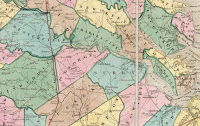 |
| Settlement of Jamestowne |
Thomas Garnett may have come from Lancashire in England. English records show that there were Garnetts settled there from at least the 12th century and the parish records for the church at Kirkby Lonsdale, Lancashire show a Thomas Garnett, son of Robert Garnett, baptised there on the 14th of December 1585.
It appears that Thomas Garnett came to the American colonies as an indentured servant to Capt. William Powell. Tyler, Narratives of Early Virginia cites a conflict between Thomas Garnett and Capt. Powell from the record of the first meeting of the elected assembly at Jamestown on August 3, 1619:
Captaine William Powell presented a pettition to the generall Assembly against one Thomas Garnett, a servant of his, not onely for extreame neglect of his business to the great loss and prejudice of the said Captaine, and for openly and impudently abusing his house, in sight both of Master and Mistress, through wantonnes with a woman servant of theirs, a widdowe, but also for falsely accusing him to the Governor both of Drunkennes and Thefte, and besides for bringing all his fellow servants to testifie on his side, wherein they justly failed him. It was thought fitt by the general assembly (the Governour himself giving sentence), that he should stand fower dayes with his eares nayled to the Pillory, viz: Wednesday, Aug. 4thm and so likewise Thursday, fryday, and Satturday next following, and every of those dayes should be publiquely whipped.
 |
| The Virginia Colony |
In a "Muster of Inhabitants" taken in 1624-25, Thomas Garnett, aged 40, was living at Elizabeth City with his wife, Elizabeth, aged 26, who came in the ship Neptune in 1618, and their young daughter, Susan aged three. Elizabeth must have died sometime in 1624 because another census apparently taken later that year lists the wife of Thomas Garnett as Joyse Gyffith, age 20, who arrived in 1624 on the ship Jacob.
Whatever the truth of the conflict with William Powell, within fifteen years Thomas Garnett was no longer an indentured servant and had become a land owner in his own right. There is patent dated 3 July 1635 recorded in the Land Office at Richmond in Grant Book 1, page 201 from Governor John West granting 200 acres of land lying along the Little Poquoson Creek in Elizabeth City County to Thomas Garnett. The land was granted to Thomas Garnett for transporting four colonists to Virginia at his own expense for which he received 50 acres each.













